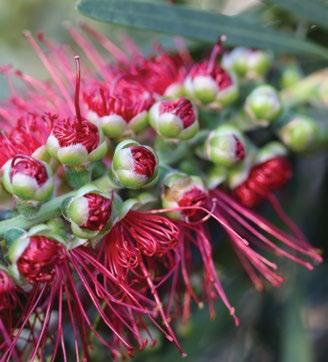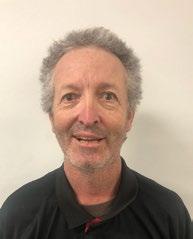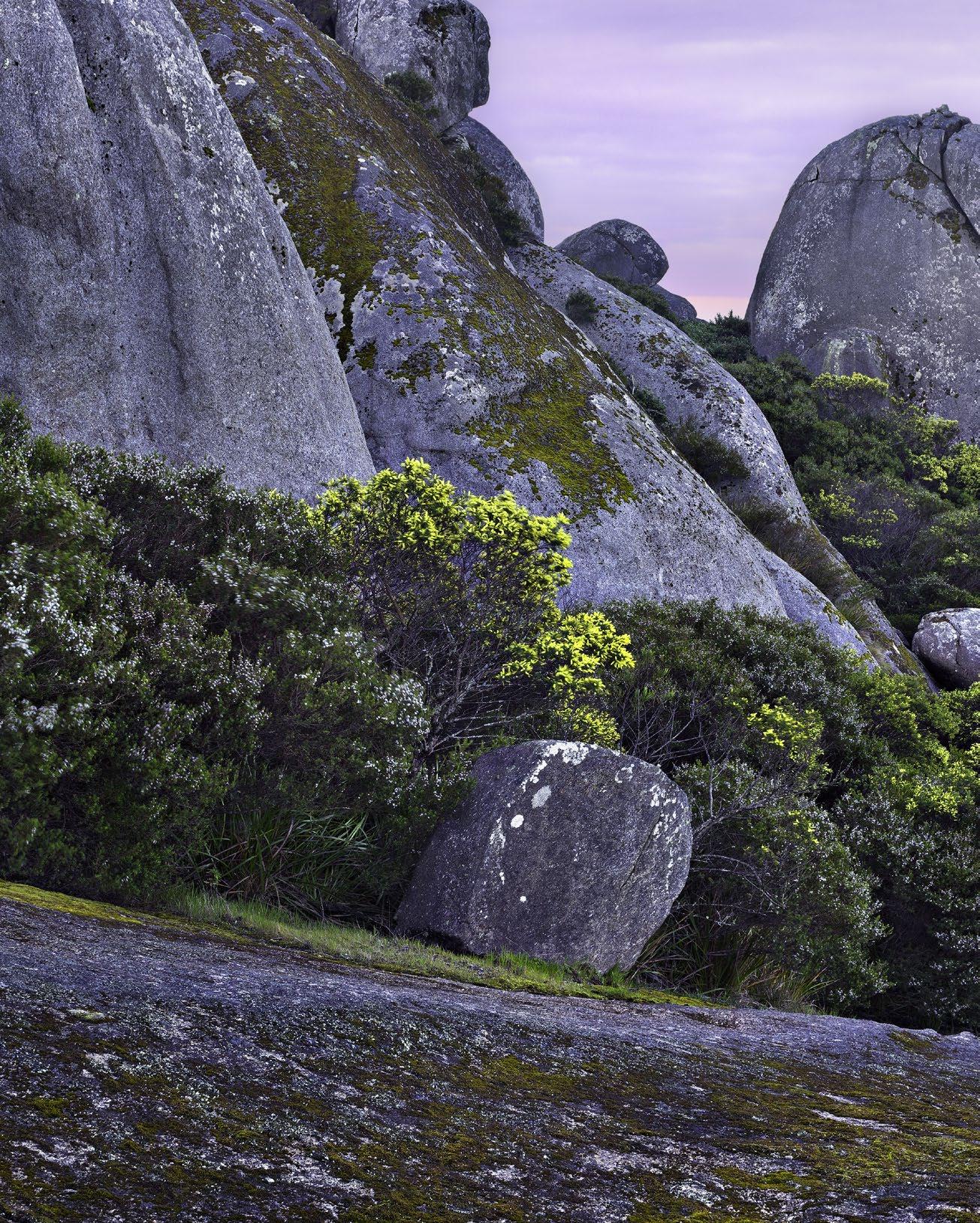Contributing
Dominic Castledine is the public information manager with the polyphagous shot-hole borer response at the Department of Primary Industries and Regional Development. His work is focused on community education and collaboration with local government agencies to help eradicate this invasive borer and protect WA’s forests and urban tree canopy. More information on PSHB can be found at agric.wa.gov.au/borer
Astravellers, we visit places to discover something new, something unique; the people, the foods, the culture and the nature of each place. It is these unique characteristics that fascinate and delight us in places newly discovered. In a state as vast as Western Australia, it never ceases to amaze me how distinctly different the natural values of each region are compared to the next.
Experiences in nature have the power to change our perspective, to calm us, to centre us and to connect us. Facilitating tourism experiences in WA’s incredible natural areas feels like a privilege and it is the focus of DBCA’s newly developed Nature-based Tourism Division.
New and emerging tourism opportunities including tours (see ‘Wanga Mia experience’ on page 44), visitor services, accommodation, events and experiences (see ‘Urban mountain biking in Perth’s north’, page 36) are being prioritised in key areas.
Promoting, facilitating and managing tourism experiences is no mean feat and takes the coordinated effort of land managers, Traditional Owners, local communities, tourism operators and not-for-profits (see ‘Wander with the wild in Mountain Country’ on page 18).
As land managers, we must strike the right balance between protecting the natural integrity of these areas so they can continue to be a home for wildlife as well as allowing access for visitors to see and enjoy them.
While a consistent framework is being established to assess and facilitate tourism opportunities, it is our responsibility, whether visitor or resident, to care for these lands and waters so that we and others may enjoy them.
Western Australia’s natural wonders have existed long before we came to be, and, with our help, will continue to exist long after we are gone.
Sveva Falletto, Executive Director, Nature-based Tourism Division Department of Biodiversity, Conservation and Attractions
Kathryn MacNeil is a passionate tourism trailblazer, tour guide and business owner in the Great Southern region. Based in Mount Barker WA, she is championing the development of sustainable tourism in the region, while leading Mountain Country Tourism, a respected not-forprofit association, into some exciting new projects. Kathryn’s love of the ancient mountains, rich Indigenous culture and abundant agricultural landscapes matches perfectly to promoting the region.
Kenny Chatelain is a general hand employed by Workpower, and previously Activ Foundation Inc. Kenny has been one of many supported employees who, for the past 40 years, have packed LANDSCOPE magazine at the Bentley and Victoria Park sites. During his 36 years’ service, Kenny unpacks the pallets and cartons, heat seals the plastic sleeves and repacks the finished product. Kenny is an enthusiastic, hardworking individual who is willing to undertake any job that needs doing, including many commercial contracts on and off site.
Editor Lauren Cabrera.
Editorial assistance Jenna Oliver.
Scientific/technical advice Margaret Byrne, Steven Dillon, Carl Gosper, Lesley Gibson, Danielle Ayres and John Huisman.
Special thanks to Andrew Burbidge.
Design and production coordinator Tiffany Taylor. Design Katie Bryden, Sonja Rose and Lynne Whittle.
Illustration Philippa Nikulinksy.
Cartography Promaco Geodraft.
Prepress and printing Advance Press, Western Australia.
All material copyright. No part of the contents of the publication may be reproduced without the consent of the publishers.
Maps should be used as a guide only and not for navigational purposes.
ISSN 0815-4465
Please do not send unsolicited material, but feel free to contact the editors by email (landscope@dbca.wa.gov.au).
Published by the Department of Biodiversity, Conservation and Attractions, 17 Dick Perry Avenue, Kensington, Western Australia. © State of Western Australia, January 2025. For more information contact us:
On the web shop.dbca.wa.gov.au
By email landscope@dbca.wa.gov.au
By phone (08) 9219 9000
By free post Reply Paid 25, Locked Bag 29, Bentley DC, Western Australia 6983
To purchase LANDSCOPE online, visit shop.dbca.wa.gov.au/landscope
LANDSCOPE is printed on recycled paper which contains 55 per cent recycled fibre and is made from pulp, which is derived from well-managed forests, controlled and recycled sources. @waparkswildlife
This page Porongurup National Park. Photo – David Bettini
New resident koalas for Yanchep
Three koalas have arrived at Yanchep National Park. Miffy, a sevenyear-old from Ballarat Wildlife Park, and Louie and Franklin Doogsie are 18-month-old brothers from Cleland Wildlife Park. Although not native to WA, koalas have been a beloved part of Yanchep National Park since 1938 and these arrivals are the first koalas to come to the park from interstate since the 1980s. They’re now part of a satellite breeding program supporting national conservation efforts.
READER’S PIC
Scarlet robin (Petroica boodang)
Photo and words by Rick Dawson
“I was out checking some artificial hollows in Steak Hill (east of Mandurah) for Carnaby’s cockatoos when this darling little scarlet robin caught my eye. I am pleased to say two out of six hollows already have cockatoo eggs, which is great as we were expecting a very late season.”
Have you got a fantastic nature photograph you would like to see published in LANDSCOPE? Send it, along with a 100-word description of the species or how and where you took the shot, to landscope@dbca.wa.gov.au.
Conservation milestone for black cockatoos
September saw a major milestone marked for endangered native black cockatoos in Western Australia.
Fifteen mature rehabilitated Carnaby’s black cockatoos (Zanda latirostris) were released into Yanchep National Park, bringing the total number of rehabilitated black cockatoos released into the wild to 1000!
Every year, hundreds of injured black cockatoos are treated at Perth Zoo vet hospital, then transferred to Kaarakin Black Cockatoo Conservation Centre or Native Animal Rescue to start their rewilding journey. For some birds, it can take years before they are fit and healthy enough to be safely returned to the wild.
Once they’re ready for release, Department of Biodiversity, Conservation and Attractions (DBCA) conservation scientists place a unique ID band on each bird so they can be tracked and monitored if they’re spotted in the wild.
This conservation achievement was made possible thanks to collaboration between Perth Zoo, DBCA, Kaarakin, Native Animal Rescue, Murdoch University and countless volunteers.
Photo
Miles Brotherson/DBCA
Above left Franklin Doogsie settling in at Yanchep National Park.
–
Right Carnaby’s black cockatoo (Zanda latirostris). Photo – Samille Mitchell/DBCA
Emperor penguin safely returned back to sea
After 20 days of dedicated care, an emperor penguin (Aptenodytes forsteri) that made an extraordinary stopover at Ocean Beach, Denmark, has been successfully released back into the Southern Ocean.
Thanks to the incredible efforts of local wildlife carers Carol and Graham Biddulph, the Antarctic traveller regained strength and health, putting on 3.5 kilograms during its recovery. With warmer weather approaching, it was critical to return the penguin to its natural environment, where it can thrive and thermoregulate.
Under the watchful eyes of a vet, wildlife officer, and its devoted carers, the penguin was released from a Parks and Wildlife Service vessel off the southern coast of WA on 20 November 2024.
Emperor penguins are known to travel up to 1600 kilometres on foraging trips, and animal scientists are optimistic this remarkable bird is ready to continue its epic voyage.
New River Journeys interpretation nodes now complete
In October 2024, two new interpretation nodes were officially opened— one at the Burswood foreshore and one at Warndoolier (Banks Reserve) as part of the River Journeys project.
The vision of the River Journeys project is to create a continuous recreation trail network with approximately 25 nodes through the Swan Canning Riverpark from Fremantle to Guildford, on both the northern and southern shores of the rivers.
Each node is an opportunity for visitors to learn about the rich culture, history, and ecology of the Derbarl Yerrigan (Swan River), and new artwork by Whadjuk artists.
This project was made possible through a collaboration between DBCA and the Burswood Park Board, with contributions from local Aboriginalowned businesses to create an immersive and meaningful space.
Visitors are invited to explore these new spaces, learn something new, and connect with stories of the river.
Guest column
Robert Taylor CEO, WAITOC
WAITOC is the peak industry body representing more than 180 Aboriginal owned and operated tourism businesses throughout WA.
Recently, 110 of these businesses were launched, creating more than 300 jobs for Aboriginal people in the industry that, in turn, supports their families and communities—often in the most remote parts of WA.
A cornerstone of our funding comes from a $20 million election commitment from the WA Government, which is delivered through Jina, the Western Australian Aboriginal Tourism Action Plan 20212025. Working closely with Tourism WA, the State tourism body, we share the aim of positioning WA as Australia’s premier destination for authentic Aboriginal tourism. We are also fortunate to have the support of philanthropic partners to help make our goals a reality.
I’m particularly proud of the recent opening of our Aboriginal Bushfood Business Base, in Mandurah. The first centre of its kind in the State, it will deliver a specialist support program to grow new and existing Aboriginal-led bushfood businesses in this very exciting, emerging sector. We envision that the hub will include a commercial kitchen, for bushfood product development, and a commercial lab for developing cosmetics and traditional medicines.
WA is uniquely positioned for growth in the natural health products sector for many reasons, not least of all because of the existence of our amazing native plants or superfoods that have thrived in geographic isolation.
For instance, gubinge (Kakadu plum), is hailed in the wellness industry as the world’s highest source of vitamin C. This fruit is well known among the Bardi people of the West Kimberley coast, where it grows in abundance, and has been wild harvested and hand processed by them for its health benefits for tens of thousands of years.
The reality is that First Nations businesses are grossly under-represented, comprising less than one per cent of growers, farm managers and exporters, and generating only one per cent of industry produce and dollar value.
This is something that we are working hard to change, while continuing to foster economic empowerment, cultural preservation, and cross-cultural understanding.
Above Traditional Owners enjoying the interpretive nodes.
Photo – Sean Renner/DBCA
Above Gus the emperor penguin.
Photo – Carol Biddulph
South Coast Marine Park
Everyone is welcome in the new South Coast Marine Park, which protects southern right whale nurseries, kelp forests, vulnerable seal and sea lion colonies, precious reefs,while maintaining opportunities for recreational and commercial fishing.
The traditional Sea Country of the Wagyl Kaip South Noongar, Wudjari, Ngadju and Western Australian Mirning Traditional Owners on the south coast of WA has a rich biodiversity found nowhere else in the world (see ‘Ancient ancestral beauty’ LANDSCOPE, Spring 2023). Southern coastal waters include spectacular granite reefs, sponge gardens, limestone reefs, seagrass meadows, kelp gardens and communities of filter feeders in deeper waters.
In November 2024, four adjacent marine parks over Wudjari, Ngadju and Mirning
native title determination areas and the eastern section of the Wagyl Kaip Southern Noongar portion of the South West Native Title Settlement were gazetted to collectively form the South Coast Marine Park.
The Mamang Maambakoort, Wudjari and Mirning marine parks are jointly managed with Wagyl Kaip Southern Noongar, Wudjari and WA Mirning Traditional Owners respectively, alongside the Department of Biodiversity, Conservation and Attractions (DBCA). The Western Bight Marine Park Management Plan enables future joint management of the park with Ngadju Traditional Owners.
The marine parks protect interconnected Aboriginal cultural places.
Significant Sea Country sites include fish traps, middens, fishing and hunting grounds, seascape features, shell sites, breeding areas and culturally important habitats such as reefs or beaches. Intangible values include stories and song lines, traditional knowledge and relationships with specific plants and animals, and enjoyment of Country and customary activities.
There are excellent recreational fishing opportunities from a boat in about 80 per cent of the parks (areas outside sanctuary zones), and along 85 per cent of the parks shoreline lines also provide these oppoortunities.
Southern right whales (Eubalaena australis) use the sheltered bays close to shore between June and November each
Above Black-headed puller (Chromis klunzingeri) and sea sponges.
Photo – Ann Storrie
Parks for people by Carolyn Thomson-Dans


























































